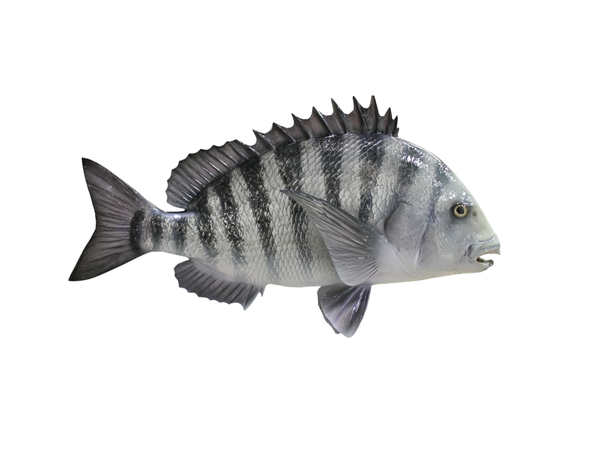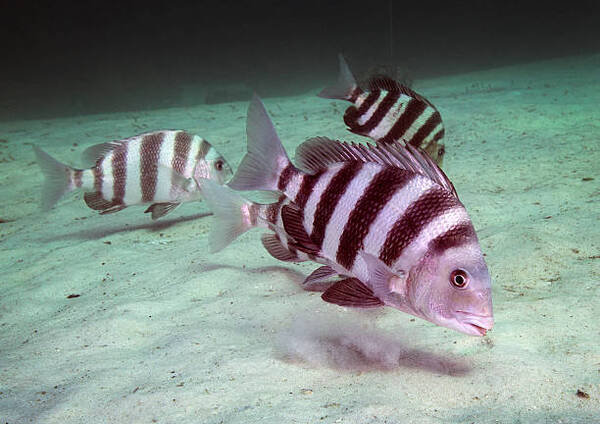The sheepshead fish is a fascinating creature of the sea that’s made headlines for a curious reason: its teeth look remarkably like human teeth! Native to the Atlantic Ocean and commonly found along the eastern coast of North America, sheepshead fish (Archosargus probatocephalus) have become internet sensations because of their unusual mouths. Let's dive into what makes these fish so unique and why they’re a wonder of the underwater world.

Sheepshead fish are medium-sized, usually growing up to 30 inches in length and weighing around 15 pounds, though most are smaller. Their body shape is distinctive, with a tall, flattened body and bold black stripes running down their sides — which is why they’re often called “convict fish.” These stripes make them easy to spot for anglers and divers alike. They’re usually found near rocky shores, docks, jetties, and bridges where they can graze on their favorite food sources.
The sheepshead's most talked-about feature is its teeth, which look eerily similar to those of humans. But why do these fish have teeth like ours? The answer lies in their diet. Sheepshead fish feed on hard-shelled creatures like crabs, barnacles, and clams. To break through these tough shells, they’ve evolved a unique set of chompers. Their front teeth are broad, flat, and closely resemble human incisors, while their back teeth are rounded, perfect for crushing.
Unlike many fish, sheepshead don’t lose and replace their teeth frequently. Their teeth grow continuously, allowing them to maintain the strength and sharpness needed to tackle tough prey. This unusual dental adaptation is crucial to their survival, giving them a versatile mouth that can handle a variety of foods.
Sheepshead fish are native to the coastal waters of the western Atlantic Ocean, from Nova Scotia in Canada all the way down to Brazil, though they’re most commonly found in the southeastern United States. They thrive in warm waters and are especially abundant in the Gulf of Mexico and along the Florida coast.

These fish are not just quirky; they also play an important role in their ecosystem. By feeding on crustaceans and shellfish, they help control the population of these species, which can otherwise become overabundant. Sheepshead fish contribute to the natural balance in their habitats by helping keep these small creatures in check.
In addition to their ecological role, sheepshead fish are popular among fishermen for their challenging catch and their flavor. With mild, white flesh, they’re considered a delicious addition to seafood dishes, often grilled or fried. However, catching a sheepshead fish isn’t easy due to their strong teeth and keen instincts.
Multi-Row Teeth: Sheepshead fish have several rows of teeth, giving them the strength they need to crack through tough shells.
Smart Swimmers: Known for being tricky to catch, these fish are often called “bait stealers” because of their ability to nibble bait without getting hooked.
Longevity: Sheepshead can live up to 20 years in the wild, a testament to their adaptability and resilience in diverse marine environments.
The sheepshead fish may not be as famous as sharks or as colorful as coral reef fish, but it has a unique charm that makes it one of the ocean’s more intriguing inhabitants. So, the next time you hear about a fish with “human teeth,” remember it’s likely the friendly sheepshead, a fish that’s carved out a place in both our hearts and on our dinner plates with its bizarre yet functional dental design. Whether you're an angler, a marine enthusiast, or simply a fan of unusual animals, the sheepshead fish is one worth keeping an eye (and a smile) out for!

The sheepshead fish might be best known for its human-like teeth, but there's much more to this quirky species. In addition to its unusual appearance, the sheepshead faces some environmental challenges, plays a significant role in its ecosystem, and has become a prized catch for anglers and food lovers alike. Let’s explore its survival threats, conservation status, diet, and why it’s considered a delicacy in many coastal communities.
While the sheepshead fish is not currently listed as an endangered species, it faces several environmental pressures. Habitat degradation due to coastal development, pollution, and the destruction of vital marine ecosystems like oyster reefs and seagrass beds can negatively impact their population. These areas are critical feeding and breeding grounds for sheepshead fish, and their loss threatens the fish’s ability to thrive.
Overfishing, while not as severe as with some other species, can also pose a risk. Sheepshead are popular among both commercial and recreational fishermen due to their taste and challenging nature. However, sustainable fishing practices have helped to maintain their population at stable levels in most regions. In the U.S., various state regulations help protect the species, including size and bag limits to prevent overharvesting.
Currently, the sheepshead fish is listed as "Least Concern" by conservation organizations, meaning it is not in immediate danger of extinction. However, continued monitoring and conservation of its habitats are essential to ensuring the species remains abundant in the future.
The sheepshead fish has an omnivorous diet, but it mainly preys on hard-shelled marine invertebrates. Thanks to their robust, human-like teeth, these fish can crush and eat a variety of prey items, including:
Crabs: A favorite food for sheepshead, their strong jaws allow them to crack open crab shells with ease.
Barnacles: The fish scrape barnacles off rocks, docks, and pilings, using their front teeth to grip and their back teeth to crush.
Clams and Oysters: With their tough outer shells, these mollusks are a challenge for many predators, but not for the sheepshead, whose teeth are built to break through.
Shrimp: Soft-bodied creatures like shrimp also make up part of their diet, providing a balance to the tougher prey they consume.
Vegetation: Though primarily carnivorous, sheepshead will sometimes eat algae and other plant materials, showing their adaptability.
Their varied diet helps them thrive in diverse coastal environments, especially in areas rich with marine life attached to rocks, docks, or coral reefs.
Sheepshead is considered a delicacy along the coasts of the southeastern United States, especially in the Gulf of Mexico. It’s a popular catch not only because of the challenge it presents to anglers but also because of its excellent flavor.
The fish’s flesh is white, firm, and mild, making it versatile for many cooking methods. Sheepshead’s taste is often compared to other mild white fish like snapper or grouper, but with a slight sweetness due to their crustacean-heavy diet.

Grilled: Grilling is a favored method for preparing sheepshead. The firm texture holds up well on the grill, and the fish can be enhanced with simple seasonings like lemon, garlic, and fresh herbs. Some prefer to grill sheepshead whole, especially smaller catches, to retain the moisture and enhance the flavor.
Fried: Sheepshead is often breaded and fried, especially in Southern coastal kitchens. The crispy outside paired with the tender, flavorful fish makes for a delicious meal. Fried sheepshead is often served with coleslaw, hushpuppies, or a dipping sauce like tartar or remoulade.
Baked: Baking sheepshead with herbs, butter, and a splash of white wine is another great option. The fish retains its moisture and absorbs the flavors of whatever ingredients are added. Baked sheepshead is commonly served with steamed vegetables or potatoes.
Fish Tacos: In recent years, sheepshead has become popular in fish tacos. The mild flavor and firm texture are perfect for seasoning with spices like cumin, paprika, and chili powder, and the fish pairs wonderfully with fresh salsa and avocado.
The sheepshead fish may be famous for its human-like teeth, but it’s much more than just a curiosity. Despite facing habitat loss and the risk of overfishing, the species remains resilient, thanks in part to its adaptability and the protective measures in place. In the culinary world, it’s celebrated for its mild flavor and versatility, making it a staple in many coastal kitchens.
Whether you’re fishing for sport, concerned about conservation, or simply looking to try a new seafood dish, the sheepshead is a fascinating and valuable species that deserves our attention and respect.
animal tags: sheepshead-fish
We created this article in conjunction with AI technology, then made sure it was fact-checked and edited by a Animals Top editor.